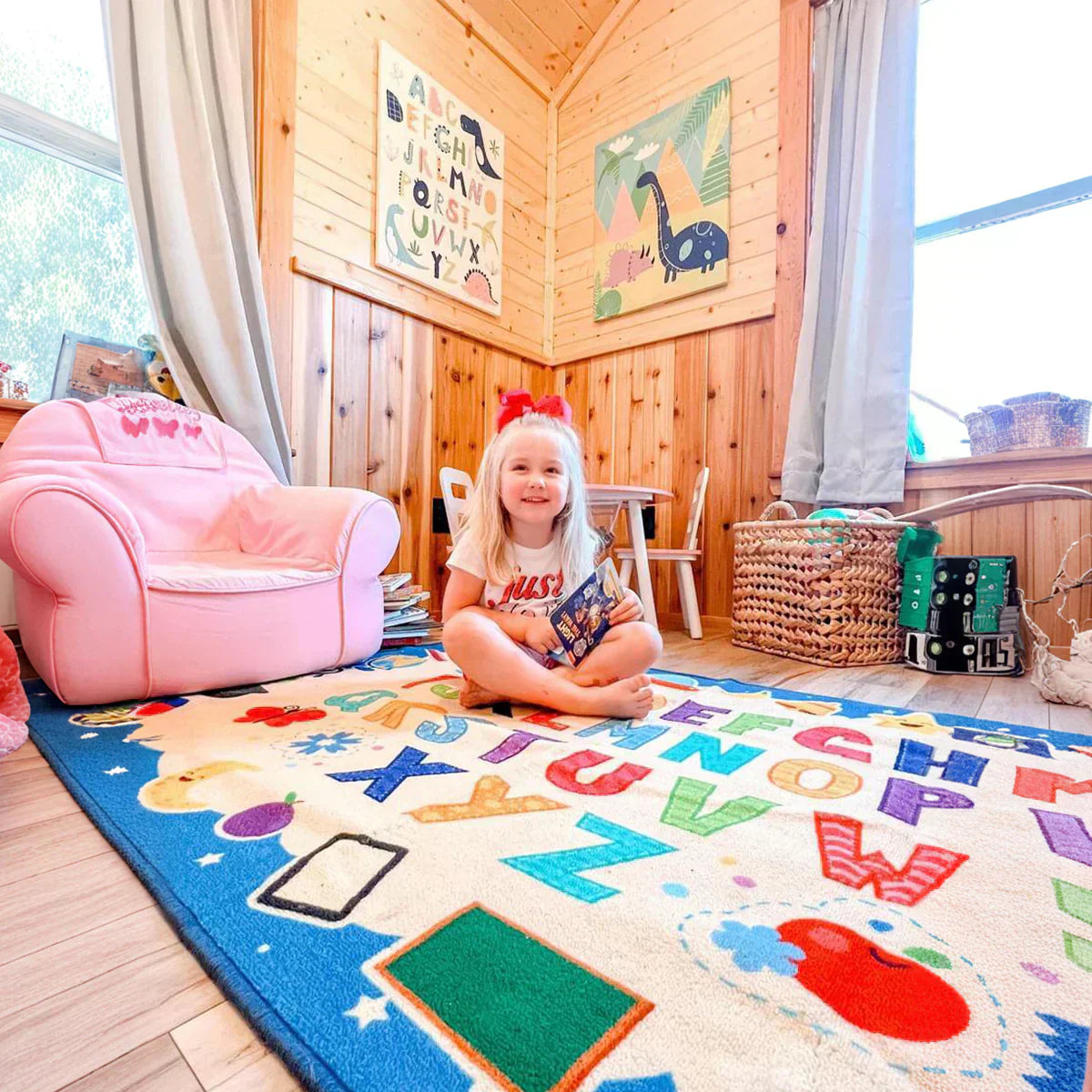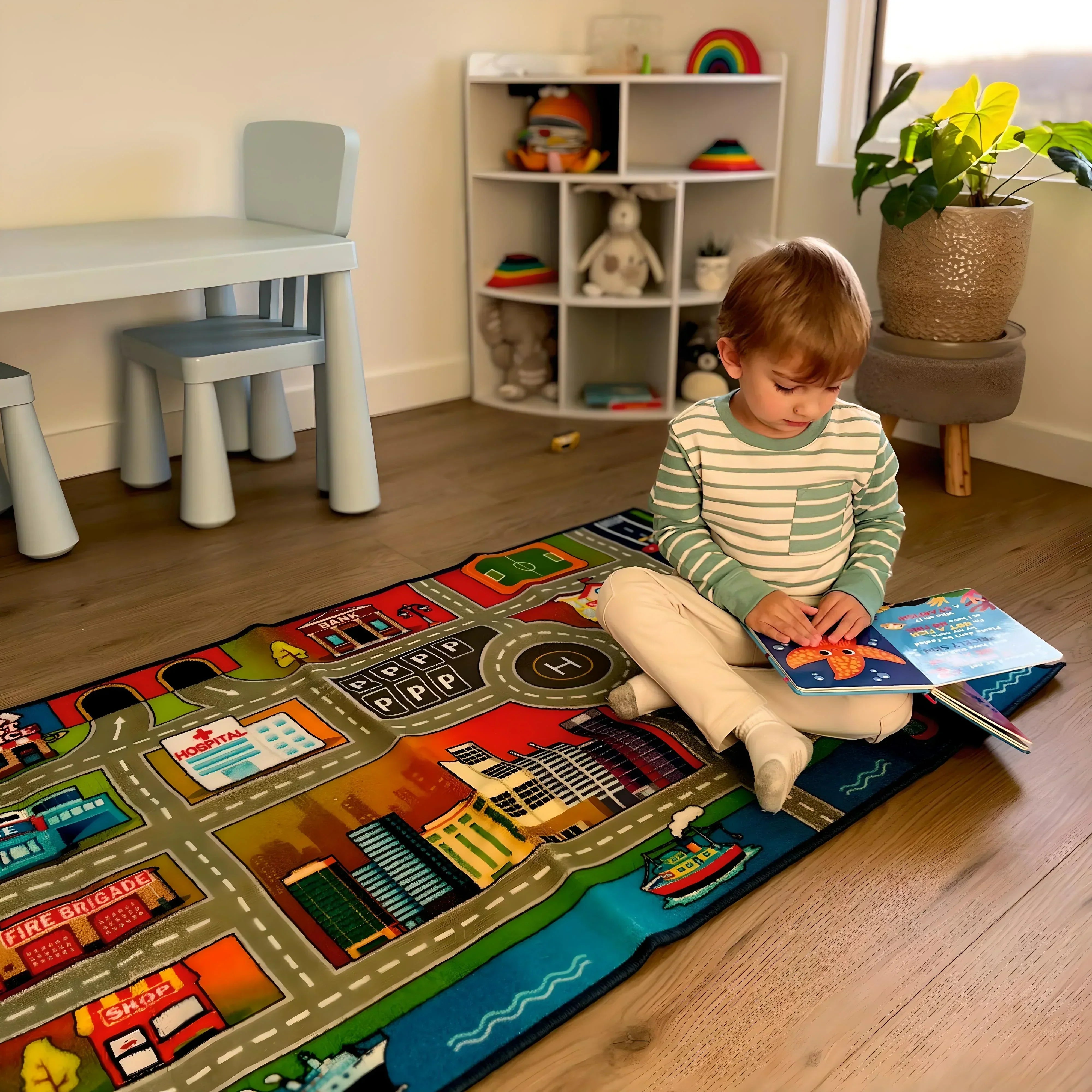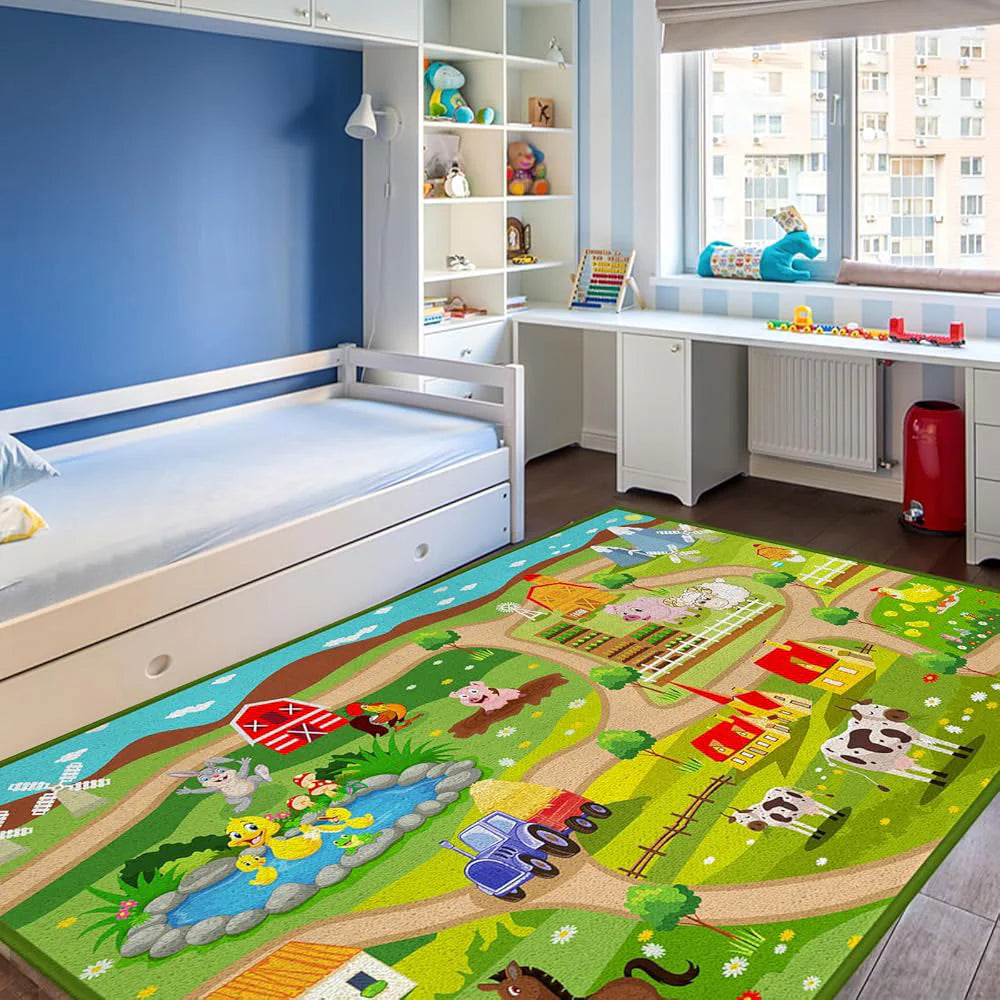The Science Behind Color Psychology in Children's Rooms
Color psychology research demonstrates that children are particularly sensitive to their environmental surroundings, with colors significantly affecting their emotions, behavior, and even cognitive performance.
Studies show that children who work or learn in certain colored rooms benefit from increased concentration and have better memory recall, while other colors can help reduce anxiety and promote better sleep patterns.
Key Research Findings:
- Blue tones can help reduce anxiety and aggression, creating a calming atmosphere for children prone to tantrums or hyperactivity
- Some studies show that children who work or learn in yellow rooms benefit from increased concentration and have better memory recall
- Soft blues and greens can create a calming atmosphere, reducing anxiety and promoting focus
- Colors significantly affect emotions and behavior. Warm colors like red and yellow often evoke feelings of energy and excitement
Understanding these psychological impacts helps parents make informed decisions about their children's bedroom colors, creating spaces that support healthy development and positive emotional experiences.
The Ultimate 2025 Guide to Color Psychology & Rugs
Creating the perfect bedroom environment for your child involves much more than selecting cute furniture and organizing toys.
The colors you choose for your child's space have a profound psychological impact on their mood, behavior, sleep quality, and overall development.
Understanding color psychology can help you design a bedroom that not only looks beautiful but actively supports your child's emotional well-being and cognitive growth.
At Booooom Jackson, we believe that every element in a child's room—from wall colors to floor coverings—should work together to create a nurturing, safe, and inspiring environment.
Our rigorously tested rugs, which meet ASTM International and CPSC safety standards, are designed to complement any color scheme while providing the comfort and security children need to thrive.
2025 Trending Colors for Children's Bedrooms
Nature-inspired themes for kids' bedrooms are set to be a top trend in 2025.
Shades like sage green, dusty blue and terracotta, which are great for creating a calming, grounded atmosphere while also being a versatile choice for different age groups.
Top Color Trends for 2025:
- Earthy Natural Tones Earthy, desert-inspired hues like tans, taupe, ivory, creams, and light browns will dominate interiors in children's bedrooms.
- These colors provide a grounding foundation that grows with children and supports various décor themes.
2. Soft Sage Green Deep, muted green is one of the top choices for bedroom color schemes, with colors like Benjamin Moore's Caldwell Green, Peale Green, and Tate Olive feeling grounding and restful
3. Warm Neutrals with Colorful Accents After years of neutrals and minimalist palettes dominating design, there's a strong move toward richer, warmer tones balanced with playful, bright accents that can be easily changed as children grow.
4. Dusty Blue and Terracotta Dusty blue and terracotta are great for creating a calming, grounded atmosphere while also being a versatile choice for different age groups
Color-by-Color Guide: What Each Hue Does for Your Child
Yellow: The Happiness Booster
Yellow is like a burst of sunshine that fills the room with energy and happiness. It is a vibrant and energetic color that can stimulate creativity and optimism. Research shows that yellow can enhance concentration and memory recall, making it excellent for study areas within bedrooms.
Best Applications:
- Accent walls rather than full room coverage
- Cheerful accessories like educational rugs with yellow highlights
- Paired with calming blues or greens for balance
- Study nooks and creative play areas
Caution: If you have a child who tends to fight bedtime, or wake up early, yellow is probably going to make that problem worse
Green: The Natural Calmer
Greens and earth tones are known to have a soothing effect, making them ideal for creating a nurturing and peaceful environment. Green is often called the easiest color on the eye and can help reduce stress levels.
Benefits for Children:
- Some studies indicate that green may increase reading ability, as well as reading comprehension
- Creates connection to nature and outdoor play
- Supports balance and emotional regulation
- Excellent for children with sensory sensitivities
Design Ideas:
- Sage green walls with white trim
- Forest green accent rugs in reading corners
- Nature-themed colorful classroom rugs for play areas
Blue: The Peaceful Sleep Promoter
Blue can make you feel relaxed and peaceful. Incorporating shades of blue, such as pastel blues or aquamarine, can help create a peaceful atmosphere in your child's room. Blue is particularly beneficial for children who struggle with anxiety or sleep issues.
Psychological Benefits:
- Blue can reduce stress and promote tranquility, making it suitable for bedrooms where relaxation is key
- Helps lower heart rate and blood pressure
- Promotes better sleep quality
- Reduces hyperactivity and restlessness
Red: The Energy Activator (Use Sparingly)
Red is an especially stimulating color. Some studies show that red even increases your heart and breathing rate. While red can increase focus and energy, it should be used carefully in children's bedrooms.
Smart Usage:
- Small accent pieces rather than wall color
- Sport-themed accessories
- Balanced with calming colors
- Avoid in bedrooms of children with attention or sleep issues
Purple: The Creative Inspirer
Purple is a color associated with creativity, spirituality, and relaxation. It combines both the calming properties of blue and the energy of red. Purple works particularly well for encouraging artistic expression and imagination.
Age-Appropriate Color Strategies
Babies and Toddlers (0-3 years)
For nurseries, focus more on the feeling you want to have in the room since you'll be spending hours upon hours in the space. Soft, muted tones work best for this age group.
Recommended Colors:
- Soft pastels: light pink, baby blue, pale yellow
- Warm neutrals: cream, beige, light gray
- Gentle greens for a nature-inspired calm
Rug Considerations:
- Hypoallergenic materials safe for crawling
- Soft textures for tummy time
- Easy-to-clean surfaces for inevitable spills
Preschoolers (3-5 years)
Psychologists say young children prefer bright, saturated colors and playful decorations. Pure room colors of the primary spectrum are perfect for children's rooms.
Color Strategy:
- Bright, cheerful primary colors as accents
- Educational elements like alphabet or number rugs
- Balance stimulating colors with calming base tones
School-Age Children (6-12 years)
Children as young as two have an opinion, so ask your child what favorite color he wants to incorporate into the room. This age group benefits from having input in color decisions while maintaining psychological benefits.
Approach:
- Involve children in color selection process
- Focus on colors that support homework and concentration
- Create zones with different color schemes for various activities
The Role of Rugs in Children's Color Psychology
Rugs play a crucial role in implementing color psychology principles in children's bedrooms. Bright, bold accessories like cushions, rugs, and curtains in coordinated hues can add playful elements to the space while providing the psychological benefits of specific colors.
Why Rugs Are Essential for Color Strategy:
1. Flexible Color Implementation Unlike paint, rugs allow you to introduce significant color without permanent commitment. As children's preferences evolve, rugs can be easily changed to accommodate new color schemes.
2. Textural Benefits Sensory tools like low pile classroom rugs, soft cushions, and fidget toys can cater to students' diverse sensory needs, making them feel more comfortable. The combination of color and texture provides multi-sensory benefits.
3. Defined Spaces Colorful rugs help create defined spaces within a bedroom—reading corners, play areas, or quiet zones—each serving different psychological functions.
4. Safety and Comfort Our rugs feature slip-proof backing and are made with non-toxic, eco-friendly materials, ensuring color benefits don't compromise safety.
Creating Balanced Color Schemes with Rugs
The 60-30-10 Rule for Children's Rooms
Apply the classic design rule with child psychology in mind:
- 60% - Neutral, calming base (walls, large furniture)
- 30% - Primary psychological color (rugs, major accessories)
- 10% - Accent colors for energy and interest (smaller accessories)
Color Combinations That Work
Calming Combination:
- Base: Soft sage green walls
- Primary: Cream and blue patterned rug
- Accent: Warm yellow pillows and artwork
Energizing Combination:
- Base: Warm white walls
- Primary: Colorful rainbow or geometric rug
- Accent: Bright orange and red decorative elements
Focusing Combination:
- Base: Light gray walls
- Primary: Educational rug with muted colors
- Accent: Single bright color in organizational accessories
Common Color Mistakes to Avoid
Overstimulation Errors
Too much exposure to red seems like it may trigger aggression in some children, especially toddlers. Similarly, excessive use of any stimulating color can create restlessness.
Prevention Strategies:
- Use bright colors in moderation
- Balance stimulating colors with calming ones
- Consider your child's specific personality and needs
Ignoring Room Function
If you have a child who tends to fight bedtime, yellow is probably going to make that problem worse. Consider how colors affect the room's primary functions.
Trend Over Psychology
While staying current with trends is appealing, prioritize psychological benefits over temporary aesthetic preferences.
Practical Implementation Tips
Start Small
Begin with colorful rugs and accessories before committing to wall colors. This allows you to observe your child's response to different hues.
Consider Lighting
Natural and artificial lighting significantly affects how colors appear and feel in a room. Test colors in different lighting conditions.
Think Long-Term
Choose neutral base colors if the room's painted in neutral tones, it's easier to pair with pre-existing furniture or design preferences. Build flexibility into your color scheme.
Quality Matters
Invest in high-quality, durable rugs that maintain their color integrity over time. Our nylon fiber construction resists fading while providing lasting beauty.
Safety Considerations for Colored Children's Rugs
When selecting colorful rugs for children's bedrooms, safety must remain the top priority:
Essential Safety Features:
- Non-toxic dyes and materials
- Slip-resistant backing
- Hypoallergenic properties
- Fire-resistant materials
- Easy-to-clean surfaces
At Booooom Jackson, we "test like paranoid grandmas" to ensure every rug meets the highest safety standards while delivering the color psychology benefits children need.
Seasonal Color Adaptations
Spring/Summer Approach
- Lighter, airier colors
- Fresh greens and soft blues
- Increased natural light considerations
Fall/Winter Approach
- Warmer, cozier tones
- Rich oranges and deep blues
- Compensation for reduced natural light
Special Considerations for Different Personalities
Highly Sensitive Children
- Favor muted, soft versions of beneficial colors
- Avoid high-contrast combinations
- Prioritize calming blues and greens
High-Energy Children
- Use calming colors as primary scheme
- Add energizing colors sparingly
- Focus on grounding earth tones
Shy or Introverted Children
- Orange is a bright and cheerful color that has been shown to enhance communication, and socialization
- Warm, encouraging colors in moderate amounts
- Avoid overwhelming or overly stimulating schemes
Budget-Friendly Color Psychology Implementation
Maximize Impact with Rugs
Large area rugs provide significant color impact at a fraction of the cost of room painting and furniture replacement.
Layering Strategy
Use multiple smaller rugs to create color zones and visual interest while staying within budget.
Seasonal Rotation
Invest in a few quality rugs in different color schemes and rotate them seasonally for fresh psychological benefits.
Maintenance and Longevity
Protecting Color Investment
- Regular vacuuming maintains color vibrancy
- Immediate spot cleaning prevents permanent staining
- Professional cleaning extends rug life
Color-Safe Cleaning
Use pH-neutral cleaners that won't affect dye integrity or child safety.
Creating Multi-Functional Color Zones
Reading Corner
- Soft greens and blues for concentration
- Comfortable, medium-pile rugs
- Adequate natural lighting
Play Area
- Bright, energizing colors
- Durable, easy-clean surfaces
- Safety-focused materials
Sleep Zone
- Calming blues and muted tones
- Soft, comforting textures
- Minimal stimulating colors
Future-Proofing Your Color Choices
Growing with Your Child
Select foundational pieces that accommodate changing preferences while maintaining psychological benefits.
Adaptable Accents
Use rugs and accessories to evolve color schemes without major room overhauls.
Investment Pieces
Choose quality rugs that maintain their color and function through multiple developmental stages.
Conclusion: Creating Colorful, Healthy Spaces
The colors in your child's bedroom do far more than create aesthetic appeal—they actively influence your child's mood, behavior, and development.
By understanding color psychology and implementing these principles through thoughtful rug selection and room design, you can create a space that supports your child's emotional well-being while reflecting their unique personality.
Remember that the best color scheme is one that balances psychological benefits with your child's individual needs and preferences.
Whether you choose the happiness-boosting properties of yellow, the calming effects of green, or the creative inspiration of purple, the key is creating a harmonious environment where your child can rest, play, and grow.
Transform your child's bedroom today with colors that nurture their development and rugs that prioritize both beauty and safety.
At Booooom Jackson, we're committed to helping you create spaces where children can thrive emotionally, mentally, and physically.
Ready to start your color psychology journey? Explore our collection of safety-certified, colorful rugs designed to complement any bedroom color scheme while supporting your child's healthy development.
External Resources:




Leave a comment
This site is protected by hCaptcha and the hCaptcha Privacy Policy and Terms of Service apply.